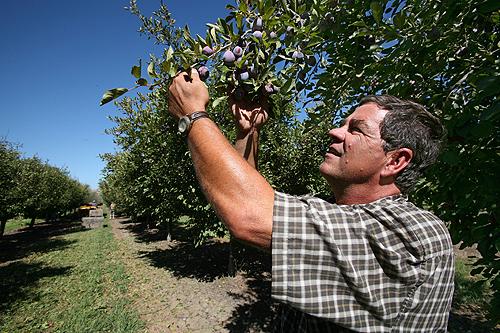Prune farms predict shriveled yield

Peter Righero, farm manager at Giovannetti & Sons, checks plums in an orchard being harvested to make prunes near Yuba City, Calif., on Aug. 13. Heat has affected American prune farms responsible for 99 percent of the U.S. supply. THE ASSOCIATED PRESS, STEVE YEATER
August 24, 2007
YUBA CITY, Calif. – At the orchard he manages in the heart of California prune country, Peter Righero watched unhappily as harvesting machines shook each tree and more leaves and twigs appeared to fly into the air than plums.
The plum trees usually produce about 2,500 tons of dried prunes annually. This year, Righero said he will be lucky to get 1,000 tons after temperatures soared into the 80s during the March bloom period around St. Patrick’s Day.
“It’s kind of hard to think your whole year can be shaped around three or four days,” said Righero, farm manager at the family-owned B.E. Giovannetti & Sons orchard north of Yuba City. “We’re not going to make any money on this year’s crop.”
The outlook is similar across the region’s 72,500 acres of prune orchards, which grow 99 percent of U.S. prunes and 60 percent of the world’s supply.
The California Agricultural Statistics Service predicts that growers will harvest about 95,000 tons this year, a 49 percent drop from the 187,737 tons harvested in 2006 – or about 11 million fewer prunes.
Get The Daily Illini in your inbox!
In the prune industry, the shortfall will affect a string of businesses: the companies that dry the plums into shriveled prunes in large heating tunnels; the storage facilities that keep the prunes in climate-controlled environments; and the processing plants that package and can the prunes for grocery stores.






